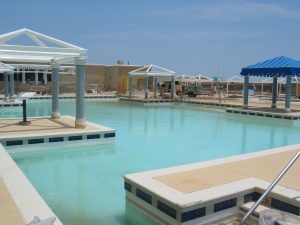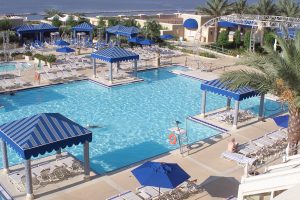The 2019 hurricane season is here and from June 1 through November 30 everyone along the coasts will be gearing up for the windy ride. When it comes time to defend your home or business, you will board up windows and doors, place sandbags around your property and then evacuate with your family and pets. But, what about your swimming pool?
From flying debris to wave surges and flood waters, your swimming pool is just as prone to damage and contamination as your home or business. Here are a few tips you can take to prepare your swimming pool for a hurricane or tropical storm.
BEFORE THE STORM
Do Not Drain the Pool
Yes, you heard that right. The weight from the water helps keep the pool in place. Draining the water can cause the pool to move around or even come out of the ground due to the pressure from the excessive water underneath it. The water also helps protect your pool’s finish or lining from debris the winds throw around and makes cleaning up after the storm much easier.
Leave the Pool Cover Off
Covering the pool can be more expensive in the end than just cleaning out debris from the pool itself. Flying debris such as trees, furniture, siding, etc. can puncture the cover, causing extensive damage and a very costly one at that.
Add Chlorine
It’s important to start fighting contaminants and bacteria before the storm even hits. The strong wind and heavy rainfall will not only bring plenty of unwanted material into your pool water, but it may cause the power to fail. Without electricity, the filtration, cleaning and system equipment can’t do their job, so the extra chlorine will help maintain the pool.
Turn Off and Store Electrical Pool Equipment
Any electrical equipment such as pump motors, pool lighting, chlorinators, heaters, time clocks, etc. need to be turned off from the main electrical panel. If you can’t wrap them in a waterproof plastic, it’s recommended to remove these items and store them in a high and dry place away from possible flood waters. If you leave them running during the storm, damage is likely and you may have to replace them.
Remove and Secure Any Surrounding Furniture
Chairs, chaises, tables, umbrellas, grills, etc. — all of these need to be removed from the pool area or secured in place. If left outside or unsecured, these items can become dangerous weapons as the high winds turn them into projectile pieces and send them into unexpected places. You will also be fishing these out of the pool.
AFTER THE STORM
Check Your Surroundings
Once the storm has passed and it’s safe to start cleaning up, check your surroundings first. Make sure there are no downed power lines in or near the pool or any other water source.
Don’t Turn the Power On and Check All Pool Equipment
You must remove any debris that is in the pool and check for any damage before turning any of the electrical equipment back on. Make sure you inspect the entire pool and its equipment for any cracks or leaks. Not doing so can cause electrical shock and further harm to the pool equipment systems. If any pool electrical equipment was submerged in water or became wet, it should not be powered until it has been inspected by a licensed electrician. Once you’ve thoroughly cleaned the pool and equipment, checked for any electrical damage and have been given the all clear, you can turn the power back on.
Do Not Drain the Pool
Just like before the storm, you don’t want to drain the pool entirely, no matter how dirty the water is. You still need that support to keep the pool in place as it can still shift due to the added water that is underneath it. You can, however, remove any excess water that made its way into the pool and bring the water levels back to where they need to be.
Clean the Pool and All Equipment
Now that you’ve removed all debris from the pool and its systems, you can start the cleaning process. You will want to clear the pump strainer and skimmer basket(s) for any buildup to avoid clogs within the system. Next, clean the filter out and then backwash it multiple times to ensure all dirt and particles are removed. Finally, clean the pool walls and floor with a vacuum and brush. You will probably need to repeat this process more than once to get the water clean and clear.
Check Chemical Levels
Before you jump into the pool, whether it’s for leisure or to clean debris out, you need to check the water and chemical levels. Depending on the amount of chlorine you added before the storm, along with any dirt, mud, flood waters or other unwanted materials, the water can be highly contaminated or chlorinated. This can cause health issues such as skin rashes, breathing trouble and gastrointestinal problems. Once the pool is clear of debris, you can start adding the chemicals needed to “shock” the pool and balancing the water chemistry to bring all levels back to normal.
Clear the Water
You’ve removed the debris, cleaned the pool and its systems, and checked the chemical levels, it’s time to run the filtration and circulation systems until the water is clean and clear. This will take some time, possibly days, to complete this step. The systems will need to run continuously during this time and you will want to keep checking the filter and skimmer baskets to avoid clogs. Once the pool is clear and all levels are where they should be, you can open the pool to swimmers once again.
If your pool doesn’t survive this hurricane season and you’re looking for a system that can withstand the next one, consider stainless steel for your pool or equipment. The metal provides lasting durability and resistance against corrosion, saltwater, cracking, peeling and more. A prime example of a durable stainless steel pool is Beau Rivage Resort & Casino in Biloxi, Mississippi. The pool, which is located on the second-floor deck of the casino barge, survived Hurricane Katrina in 2005. Although the casino itself was heavily damaged by the 30ft storm surge, the pool was still holding water and structurally intact. Take a look at some before and after images below.
When it comes to building or renovating a swimming pool in hurricane-prone areas, you have options. Talk to Natare today.


Note: The first image above was taken during cleanup/reconstruction of the hotel and pool.

